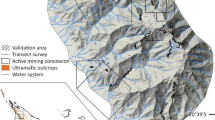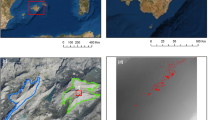Abstract
Species Distribution Models are key in modern ecological studies. They employ information about species locations and environmental factors to generate statistical functions that predict the potential distribution of species on the basis of landscape suitability. Although these models are powerful and useful tools, often the required information about species distribution is lacking, and the only resources are pre-collected museum data. Phytosociological databases contain a myriad of relevés with precious information, but are often considered to be the exclusive ownership of vegetation scientists. Our study tested the efficiency of a phytosociological database in the building of Species Distribution Models, including spatial autocorrelation (SAC) as a predictor to evaluate its effects on model performance. Spatial autocorrelation (SAC) is a natural characteristic of species distribution that depends on exogenous and endogenous processes. The latter’s effects could be overestimated by a subjective sample choice. We chose Festuca riccerii, an Italian endemic species. We split the whole dataset (671 relevés) into a calibration (443 relevés) and testing set (228 relevés) and performed a GLM on these data to identify the main ecological factors that lead distribution in order to build a Species Distribution Model. The dataset’s efficiency was assessed by testing the predicting power of the calibrated model on the testing subset. The phytosociological database proved to be good for building model (AUC = 0.821), providing a useful basis for fast and low cost ecological analysis, and could be used subsequently for more detailed analyses.



Similar content being viewed by others
References
Anselin L, Florax RJGM, Rey SJ (2004) Advances in spatial econometrics: Methodology, tools and applications. Springer Verlag, Berlin
Austin M P (1980) Searching for a model for use in vegetation analysis. Vegetatio 42:11–21
Berg A, Gardenfors U, von Proschwitz T (2004) Logistic regression models for predicting occurrence of terrestrial molluscs in southern Sweden – importance of environmental data quality and model complexity. Ecography 27:83–93
Beven KJ, Kirkby, MJ (1979) A physically based, variable contributing area model of basin hydrology. Hydro Sci Bull 24:43–69
Borcard D, Legendre P (2004) Spacemaker2: Generate spatial explanatory variables to be used in multiple regression or canonical ordination. Université de Montréal, Québec
Borcard D, Legendre P, Drapeau P (1992) Partialling out the spatial component of ecological variation. Ecology 7:1045–1055
Botta-Dukát Z, Kovács-Láng E, Rédei T, Kertész M, Garadnai J (2007) Statistical and biological consequences of preferential sampling in phytosociology: theoretical considerations and case study. Folia Geobot 42:141–152
Braun-Blanquet J (1928) Pflanzensoziologie. Grundzüge der Vegetationskunde. Springer Verlag, Berlin
Brotons L, Thuiller W, Araùjo MB, Hirzel AH (2004) Presence-Absence versus presence-only modelling methods ofr predicting bird habitat suitability. Ecography 27:437–448
Chiarucci A (2007) To sample or not to sample? That is the question … for the vegetation scientist. Folia Geobot 42:209–216
Coudun C, Gegout J (2005) Ecological behaviour of herbaceous forest species along a pH gradient: a comparison between oceanic and semicontinental regions in northern France. Global Ecol Biogeogr 14:263–270
Crawley MJ (1993) GLIM for ecologist. Blackwell, Oxford
Cressie N (1991) Statistics for spatial data. John Whiley & Sons, New York
Diekmann M, Kühne A, Isermann M (2007) Random vs non-random sampling: effects on patterns of species abundance, species richness and vegetation-environment relationships. Folia Geobot 42:179–190
Dormann CF, McPherson JM, Araújo MB (2007) Methods to account for spatial autocorrelation in the analysis of species distributional data: a review. Ecography 30:609–628
Edwards TC, Cutler R, Zimmermann NE, Geiser L, Alegria J (2005) Model-based stratification for enhancing the detection of rare ecological events. Ecology 86:1081–1090
Elith J, Leathwick J (2009) Conservation prioritization using species distribution modeling. In Moilanen A, Wilson KA, Possingham H (eds) Spatial conservation prioritization: quantitative methods and computational tools. Oxford University Press, Oxford, pp 70–93
Foggi B, Rossi G (1996) A survey of genus Festuca L. (Poaceae) in Italy. The species of the summit flora of Tuscan – Emilian Appennines and Apuan Alpes. Willdenowia 26:183–215
Foggi B, Gennai M, Gervasoni D, Ferretti G, Rosi C, Viciani D, Venturi E (2007) La carta della vegetazione del SIC Alta Valle del Sestaione (Pistoia, Toscana Nord-Occidentale). Parlatorea 9:41–78
Fortin MJ, Dale MRT (2005) Spatial analysis: a guide for ecologists. Cambridge University Press, Cambridge
Franklin J, Miller J (2010) Mapping species distributions. Cambridge University Press, Cambridge
Gibson LA, Wilson BA, Cahill DM, Hill J (2004) Modelling habitat suitability of the swamp antechinus (Antechinus minimus maritimus) in the coastal heathlands of southern Victoria. Austral Biol Conservation 117:143–150
Gimaret-Caprentier C, Péllissier R, Pascal JP, Houllier F (1998) Sampling strategies for the assessment of tree species J Veg Sci 9:161–172
Gormley AM, Forsyth DM, Griffioen P, Lindeman M, Ramsey DSL, Scroggie MP, Woodford L (2011) Using presence-only and presence-absence data to estimate the current and potential distributions of established invasive species. J Appl Ecol 48:25–34
Guisan A, Zimmermann NE (2000) Predictive habitat distribution models in ecology. Ecol Modelling 135:147–186
Haining RP (1990) Spatial data analysis in the social and environmental sciences. Cambridge University Press, Cambridge
Hastie T, Pregibon D (1992) Generalized linear models. In Chambers TJ, Hastie T (eds) Statistical models in S. Wadsworth & Brooks, Cole, pp 195–248
Hédl R (2007) Is sampling subjectivity a distorting factor in surveys of vegetation diversity? Folia Geobot 42:191–198
Hirzel AH, Helfer V, Metral F (2001) Assessing habitat suitability models with a virtual species. Ecol Modelling 145:111–121
Hirzel AH, Hausser J, Chessel D, Perrin N (2002) Ecological-niche factor analysis: how to compute habitat-suitability maps without absence data? Ecology 83:2007–2036
Kadmon R, Heller J (1999) Modelling faunal responses to climatic gradients with GIS: land snails as a case study. J Biogeogr 25:527–539
Keitt TH, Bjørnstad ON, Dixon PM, Citron-Pousty S (2002) Accounting for spatial pattern when modeling organism – environment interactions. Ecography 25:616–625
Knollová I, Chytrý M, Tichý L, Hájek O (2005) Stratified resampling of phytosociological databases: some strategies for obtaining more representative data sets for classification studies. J Veg Sci 16:479–486
Lavergne S, Thuiller W, Molina J, Debussche M (2005) Environmental and human factors influencing rare plant local occurrence, extinction and persistence: a 115 year study in the Mediterranean region. J Biogeogr 32:799–811
Lájer K (2007) Statistical tests as inappropriate tools for data analysis performed on non-random samples of plants community. Folia Geobot 42:115–122
Legendre P (1993) Spatial autocorrelation: problem or new paradigm. Ecology 74:1659–1673
Lepš J, Šmilauer P (2007) Subjectively sampled vegetation data: Don’t throw out the baby with the bath water. Folia Geobot 42:169–178
Maina G, Howe HE (2000) Inherent rarity in community restoration. Conservation Biol 14:1335–1340
Mason RL, Gunst RF, Hess JL (2003) Statistical designs and analysis experiments. With Application for engineering and science. Wiley Interscience, Carthage, Missouri
Miller MJ, Franklin MJ, Aspinall R (2007) Incorporating spatial dependence in predictive vegetation models. Ecol Modelling 202:225–242
Pereira JMC, Itami RM (1991) Habitat modeling using a logistic multiple regression: a study of Mt.Graham red squirrel. Photogramm Eng Remote Sens 57:1475–1486
R Development Core Team (2011) R: A Language and Environment for Statistical Computing. Version 2.13.0. R Foundation for Statistical Computing, Vienna. Available at: http://www.R-project.org.
Smith PA (1994) Autocorrelation in logistic regression modeling of species distributions. Global Ecol Biogeogr 4:47–61
Store R, Kangas J (2001) Integrating spatial multi-criteria evaluation and expert knowledge for GIS-based habitat suitability modeling. Landscape Urban Planning 5:79–93
Thuiller W, Araújo MB, Lavorel S (2003) Generalized models vs. classification tree analysis: Predicting spatial distributions of plant species at different scales. J Veg Sci 14:669–680
Tomaselli M, Rossi G (1994) Phytosociology and ecology of Caricion curvulae vegetation in the northern Apennines (N Italy). Fitosociologia 26:51–62
Wagner HH, Fortin MJ (2005) Spatial analysis of landscapes: concepts and statistics. Ecology 86:1975–1987
Wilson JB (2007) Priority in statistics, the sensitive feet of elephants, and don’t transform data. Folia Geobot 42:161–167
Wintle BA, Bardos DC (2006) Modeling species – habitat relationships with spatially autocorrelated observed data. Ecol Applic 16:1945–1958
Zhang L, Ma Z, Guo L (2008) Spatially assessing model errors of four regression techniques for three types of forest stands. Forestry 81:209–225
Acknowledgements
Research was supported by grants from the Administration of Pistoia Province and the University of Florence. Thanks are due to Giovanni Bacaro (Siena) for helping to improve the paper. Thanks also to Sheela Raman (New York) for improving the language.
Author information
Authors and Affiliations
Corresponding author
Rights and permissions
About this article
Cite this article
Guidi, T., Foggi, B. Use of Phytosociological Databases for Species Distribution Models. Folia Geobot 47, 305–316 (2012). https://doi.org/10.1007/s12224-012-9124-2
Received:
Revised:
Accepted:
Published:
Issue Date:
DOI: https://doi.org/10.1007/s12224-012-9124-2




